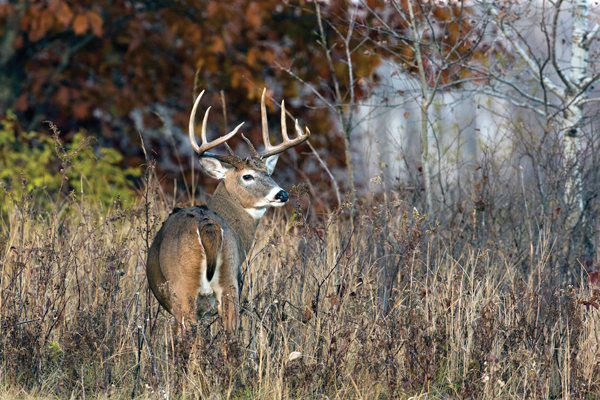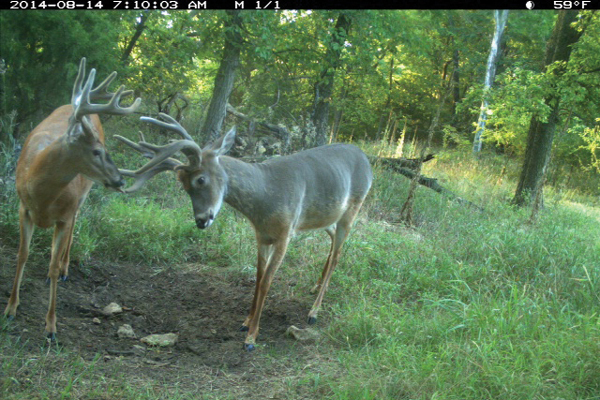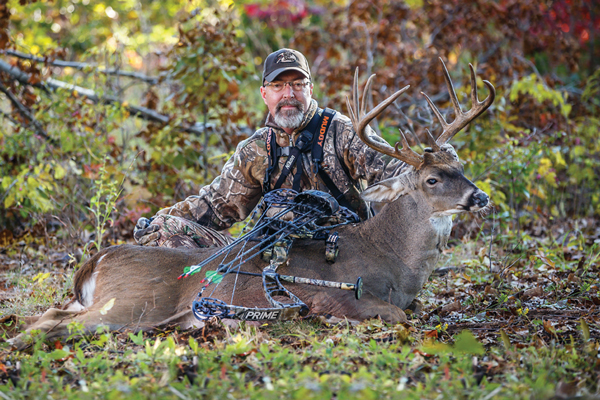January 27, 2015
By Dr. Grant Woods
 More and more archers are passing young bucks with the hope of tagging a more mature animal. In fact, the percentage of yearling bucks in the annual U.S. buck harvest has been decreasing for nearly a quarter century — from 62 percent in 1989 to 37 percent in 2012, according to the Quality Deer Management Association.
More and more archers are passing young bucks with the hope of tagging a more mature animal. In fact, the percentage of yearling bucks in the annual U.S. buck harvest has been decreasing for nearly a quarter century — from 62 percent in 1989 to 37 percent in 2012, according to the Quality Deer Management Association.
Amazingly, the QDMA reports there were five states in 2012 where at least 45 percent of all bucks killed were 3 years old or older — Texas (67 percent), Oklahoma (66 percent), Arkansas (65 percent), Louisiana (59 percent on DMAP properties) and Kansas (45 percent).
Clearly, many deer hunters have become good deer managers. And as we manage for more mature bucks, we are pushing more bucks into an age class that is more difficult to hunt!
I spent most of my 20-plus years as a wildlife biologist learning how to produce mature bucks and teaching others to do the same. It wasn't until the last five years or so that I have shifted my focus to helping hunters pattern and kill those older bucks. It's been my experience that teaching folks how to grow mature bucks is easier than teaching them to successfully hunt them.
Advertisement
In this article, I'll share some strategies for patterning and tagging a mature buck this fall.
Early-Season Strategy
During the early season, daytime temperatures are often very warm. However, bucks in most states will already have shed their reddish summer coats and grown their dark gray winter coats. If we overdress for the temperatures, we usually remain inactive or change to lighter clothing. Bucks can't change to lighter clothing, so their best option is to remain inactive during daylight hours.
Advertisement
 Understanding this biology can certainly help hunters select the best stand for current conditions. Bucks will likely be bedded in an area that provides shade and a breeze. This often means bucks will be bedded on north slopes and/or by sources of water where the air may be cooled by evaporation.
Understanding this biology can certainly help hunters select the best stand for current conditions. Bucks will likely be bedded in an area that provides shade and a breeze. This often means bucks will be bedded on north slopes and/or by sources of water where the air may be cooled by evaporation.
Bucks most likely won't bed in areas such as native grass fields where very little breeze reaches the ground and the sun would be shining directly through the opening of the cover and onto the deer.
Don't consider where a deer beds as a permanent place such as your bedroom. We humans primarily bed in the same place day after day as we control the temperature (thermostat and windows) and security (locked door, firearms, etc.). Deer can't control the temperature or security of their environment.
To compensate, they may change their locations daily or several times a day to find suitable temperatures and security conditions. Hunting the same stand location without regard to a deer's current needs rarely results in used tags.
Pre-Rut Strategy
Throughout much of the whitetail's range, temperatures normally begin to cool off a bit by mid October. The average first frost date at my home in southern Missouri is Oct. 10. By this time, mature bucks have had a month or more to adjust to wearing their winter coats. Clearly, their average testosterone levels are rising as their necks are starting to enlarge and rubs and scrapes are starting to be common throughout their range.
Very few does are receptive yet, so the bucks are still on a pattern of going to food and cover. They are not likely going to deviate much from their food to cover pattern or the core area of their home range. Most researchers refer to a buck's core area as an area within his home range where he spends at least 50 percent of his time. Core areas are often much smaller than his annual home range size.
Because bucks spend so much time in their core area, there will obviously be substantially more rubs and scrapes in most mature bucks' core areas. The pre rut is the best time to hunt an area based on where rubs and scrapes are located, as bucks will often revisit these signposts most frequently during this time of year.
Notice I said to hunt "an area based on where rubs and scrapes are located;" NOT hunt over rubs and scrapes. Often times where deer make the most sign is where they feel most secure. This is often due to being located in an area where the wind frequently swirls and results in deer being able to detect predators (two- and four-legged) from any direction.
Hunting rubs and scrapes seems to work better on land with very flat topography — very few features that cause the wind to swirl. If you hunt an area with steep hills or mountains, you'll be better off to find sign and travel routes on ridge tops where the wind is much more predictable than in a narrow bottom where there may be more sign, but the wind tends to constantly swirl.
As I mentioned, most mature bucks will have an elevated testosterone level during the pre rut. However, few does are receptive, so this is a time when bucks commonly respond to grunt calls, rattling, etc. This is also a time when it is critical to maximize your scent-reduction efforts and be very cautious how you approach, hunt, and leave stands. Bucks are keyed up but haven't yet thrown caution to the wind.
The key to successfully tagging a mature buck during the pre rut is to focus on travel patterns between food and cover and look for stand locations between these two resources that allow you to be there without alerting the deer. This is why most mature bucks won't enter food sources until after dark.
They can't control where the best quality food is within their range, but they can decide where they feel most secure and comfortable — and do select bedding locations daily. They are often most vulnerable to harvest between cover (which will likely be totally in their favor) and food (which they will likely arrive at after dark). Between these two resources is often one of the best locations to successfully intercept a mature buck.
Stand/blind placement is critical during the pre rut, because you don't want to alert and condition mature bucks to avoid the area where the stands are placed.
Rut Strategy
There's more excitement among hunters about hunting the rut than any other portion of the season. This is especially true if you hunt in areas with very fragmented habitat such as land with lots of large crop fields. If the daytime temperatures are normal or cooler than normal where you hunt, there's a good chance both bucks and does will be moving during the day, especially during the first portion of the rut.
It's much easier to predict where they will be moving when the habitat consists of large openings (harvested crop fields) with limited cover interspersed. If the landscape is primarily forested with limited openings, it can be very difficult to observe deer any time of year, especially during the rut.
 During the early portion of the rut, a small percentage of does will be receptive. If the adult buck-to-doe ratio is nearly balanced, there will be a lot of competition for the few does that become receptive first. This is often when hunters see several bucks chasing a single doe. Within a few days (in many herds), most does will become receptive and there's less need for competition. This is often called the "lock down" phase. Bucks often tend does for 24-36 hours. Tending may mean hiding with the doe in thick cover so they are not pestered by other bucks. This is why I prefer hunting areas that have a view of thick cover during the rut.
During the early portion of the rut, a small percentage of does will be receptive. If the adult buck-to-doe ratio is nearly balanced, there will be a lot of competition for the few does that become receptive first. This is often when hunters see several bucks chasing a single doe. Within a few days (in many herds), most does will become receptive and there's less need for competition. This is often called the "lock down" phase. Bucks often tend does for 24-36 hours. Tending may mean hiding with the doe in thick cover so they are not pestered by other bucks. This is why I prefer hunting areas that have a view of thick cover during the rut.
It's also important to note that researchers using GPS collars have documented does taking trips outside their core and home range areas during the peak of breeding. The collars give us data on when and where deer move, but not why. No one knows if these does are being pushed by bucks, leaving their home range to seek a different buck or for some other, unknown reason.
I rarely see bucks during the peak of rut chasing does in areas where I normally expect to see lots of does. I suspect this is because mature, receptive does abandon their fawns during the rut and leave their core area in an effort to keep rowdy bucks away from their fawns. Therefore, the strategy of hunting food sources where you expect to see lots of does may not be a good strategy to tag a mature buck during the rut, as receptive does may have separated themselves from the herd.
As mentioned, the most common attraction to a mature buck during the rut is a receptive doe. That, paired with the knowledge that at least some does are known to leave their normal area, seems to add credibility to my strategy of hunting cover during the rut. It seems both receptive does and bucks seeking or tending receptive does seek the security offered by good cover — especially when they are outside their home range.
Post-Rut Strategy
My favorite time of year to hunt mature bucks is during the post rut! It shouldn't be, as there are always fewer mature bucks to hunt during that portion of season. Some of the mature bucks have been killed by predators, injured, shed their antlers early or are so conditioned to avoiding hunters that they are primarily nocturnal.
Even with those factors, there are a couple conditions that can really swing the odds in favor of the hunter during the post rut.
Bucks and does will be seeking the best quality food within their home range that they don't associate with danger. There's a big difference between scouting and finding the best food and scouting and finding the best food source that deer don't associate with danger during the late season.
Another huge factor hunters can use to their advantage is that female fawns in many areas will reach puberty if they weigh approximately 70 pounds or more during the late winter. Unlike adult does, it seems fawns rarely leave their core range when they become receptive. They tend to continue on a very regular pattern traveling to and from food and cover. Female fawns are very easy to pattern during the late season. If a female fawn becomes receptive it will often will be followed by a mature buck — right into the food plot.
Fawns often gather in groups with other fawns and visit food sources. They predictably feed in food plots and ag fields well before dark and/or after sunrise during the late season. This pattern is even more predictable if there are limited quality food sources in the area and the temperatures are colder than normal.
If the temperatures become much colder than normal, fawns tend to visit food sources during the late morning or at midday. I recently used this knowledge to tag a mature buck I had chased all season. Finally, during late December, I noticed several fawns and young bucks frequently feeding in a food plot. I felt confident one of the female fawns would become receptive and attract a mature buck into the open during midday. The strategy worked perfectly!
The Best Strategy
No matter what portion of the season you are hunting, there are some common themes you should incorporate into your strategy to tag a mature buck:
€¢ You need to have confidence there are mature bucks in the area.
€¢ You need to know where they are using different sources of food, cover and water during different seasons and based on day-to-day weather conditions.
€¢ In areas that are primarily large crop fields, cover may be the most limiting factor and easiest to use to pattern mature bucks.
€¢ If you are hunting in areas that are primarily composed of timber and cattle pasture, food may be the most limiting resource and easiest to use to pattern mature bucks.
€¢ Unless you are hunting during a major drought or in the desert Southwest, water is rarely a limiting factor and deer rarely use the same water source frequently.
€¢ It is just as important to not alert or condition the buck to your presence as it is to pattern a mature buck!
Tagging a mature buck year after year requires a well thought out strategy. By considering a deer's biological needs and the huntability of the limited resources, you have a better chance to pattern and tag a mature buck every season.
Best of Bowhunter TV's Tech Talk
Whether you're looking for sound, expert advice on how to customize your arrow fletchings or wondering what the difference is between all the peep sights on the market, Mike Carney and Tony Peterson of Bowhunter TV have your answer.
Watch them now!Best of Bowhunter TV's Moment of Truth
Because we know exactly what it's all about, we've compiled the very best of our Moment of Truth segments on Bowhunter TV. These are the best tips for you, the dedicated bowhunter, to help ensure your success this year. When one wrong decision can mean the difference between success and failure, there's no better place to turn than Curt Wells and the experts at BOWHUNTER. Check out the best Moment of Truth segments from the year, straight from Bowhunter TV.
Watch them now!Special Father's Day Hunt
It took 18 years to draw an elk tag for Unit 201, but the reward was a fantastic hunting experience with my dad and this fine bull.
Watch it now!

